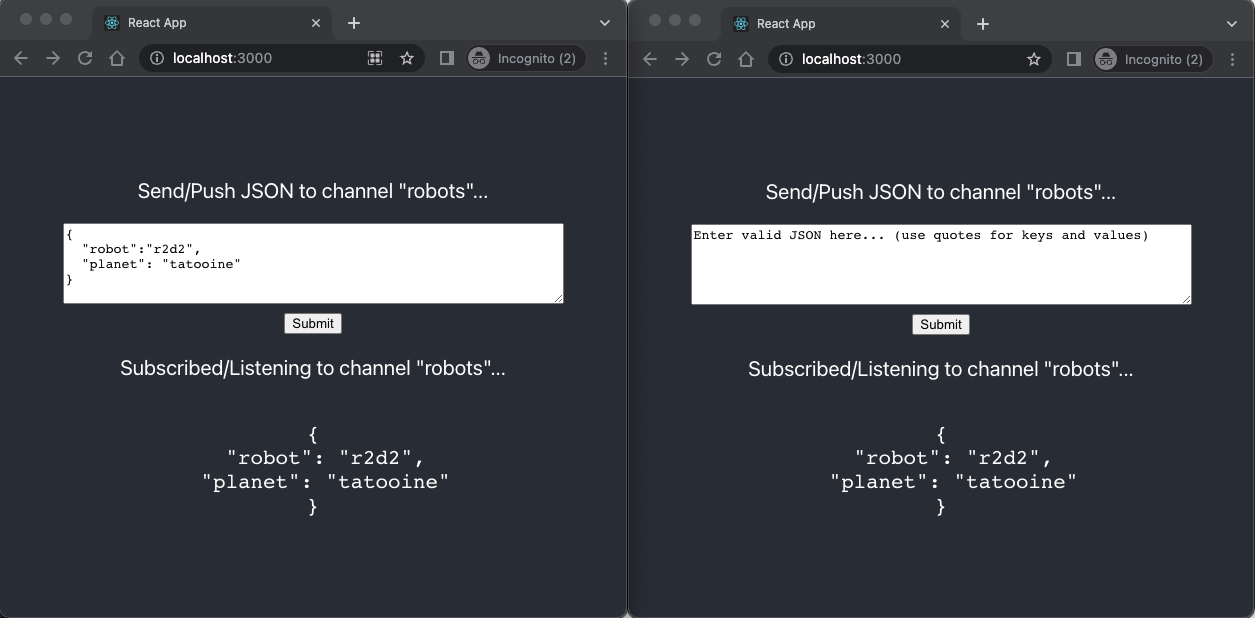Creating generic pub/sub APIs powered by serverless WebSockets in Amazon AppSync
Important
As of Mar 13, 2025, you can build a real-time PubSub API powered by WebSockets using Amazon AppSync Events. For more information, see Publish events via WebSocket in the Amazon AppSync Events Developer Guide.
Some applications only require simple WebSocket APIs where clients listen to a specific channel or topic. Generic JSON data with no specific shape or strongly typed requirements can be pushed to clients listening to one of these channels in a pure and simple publish-subscribe (pub/sub) pattern.
Use Amazon AppSync to implement simple pub/sub WebSocket APIs with little to no GraphQL knowledge in minutes by automatically generating GraphQL code on both the API backend and the client sides.
Create and configure pub-sub APIs
To get started, do the following:
-
Sign in to the Amazon Web Services Management Console and open the AppSync console
. -
In the Dashboard, choose Create API.
-
-
On the next screen, choose Create a real-time API, then choose Next.
-
Enter a friendly name for your pub/sub API.
-
You can enable private API features, but we recommend keeping this off for now. Choose Next.
-
You can choose to automatically generate a working pub/sub API using WebSockets. We recommend keeping this feature off for now as well. Choose Next.
-
Choose Create API and then wait for a couple of minutes. A new pre-configured Amazon AppSync pub/sub API will be created in your Amazon account.
The API uses Amazon AppSync's built-in local resolvers (for more information about using local resolvers, see Tutorial: Local Resolvers in the Amazon AppSync Developer Guide) to manage multiple temporary pub/sub channels and WebSocket connections, which automatically delivers and filters data to subscribed clients based only on the channel name. API calls are authorized with an API key.
After the API is deployed, you are presented with a couple of extra steps to generate client code and integrate it with your client application. For an example on how to quickly integrate a client, this guide will use a simple React web application.
-
Start by creating a boilerplate React app using NPM
on your local machine: $ npx create-react-app mypubsub-app $ cd mypubsub-appNote
This example uses the Amplify libraries
to connect clients to the backend API. However there’s no need to create an Amplify CLI project locally. While React is the client of choice in this example, Amplify libraries also support iOS, Android, and Flutter clients, providing the same capabilities in these different runtimes. The supported Amplify clients provide simple abstractions to interact with Amazon AppSync GraphQL API backends with few lines of code including built-in WebSocket capabilities fully compatible with the Amazon AppSync real-time WebSocket protocol : $ npm install @aws-amplify/api -
In the Amazon AppSync console, select JavaScript, then Download to download a single file with the API configuration details and generated GraphQL operations code.
-
Copy the downloaded file to the
/srcfolder in your React project. -
Next, replace the content of the existing boilerplate
src/App.jsfile with the sample client code available in the console. -
Use the following command to start the application locally:
$ npm start -
To test sending and receiving real-time data, open two browser windows and access
localhost:3000. The sample application is configured to send generic JSON data to a hard-coded channel namedrobots. -
In one of the browser windows, enter the following JSON blob in the text box then click Submit:
{ "robot":"r2d2", "planet": "tatooine" }
Both browser instances are subscribed to the robots
channel and receive the published data in real time, displayed at the bottom of the
web application:

All necessary GraphQL API code, including the schema, resolvers, and operations are automatically generated to enable a generic pub/sub use case. On the backend, data is published to Amazon AppSync’s real-time endpoint with a GraphQL mutation such as the following:
mutation PublishData { publish(data: "{\"msg\": \"hello world!\"}", name: "channel") { data name } }
Subscribers access the published data sent to the specific temporary channel with a related GraphQL subscription:
subscription SubscribeToData { subscribe(name:"channel") { name data } }
Implementing pub-sub APIs into existing applications
In case you just need to implement a real-time feature in an existing application, this generic pub/sub API configuration can be easily integrated into any application or API technology. While there are advantages in using a single API endpoint to securely access, manipulate, and combine data from one or more data sources in a single network call with GraphQL, there’s no need to convert or rebuild an existing REST-based application from scratch in order to take advantage of Amazon AppSync's real-time capabilities. For instance, you could have an existing CRUD workload in a separate API endpoint with clients sending and receiving messages or events from the existing application to the generic pub/sub API for real-time and pub/sub purposes only.